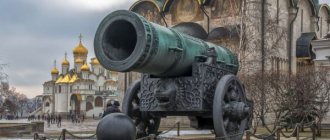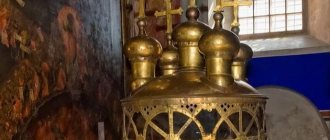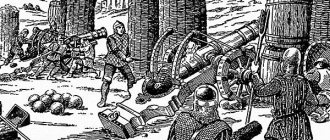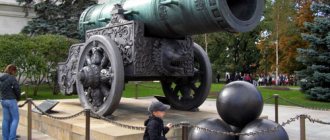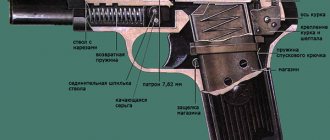The Tsar Cannon is one of the largest monuments in the world. The pedestal received this name due to the engraving of a portrait of Tsar Feodor, who was the son of Ivan IV. This grandiose monument is installed between the Church of the Twelve Apostles and the Bell Tower of Ivan the Great. The cannon is cast as a working weapon, although historians claim that in the 400 years of its existence it was never fired.
The appearance of the monument was facilitated by the anticipation of an attack on Moscow by the army of the Crimean Khan. This cannon was installed on a hill to provide reliable protection of the Spassky Gate. The question of whether this weapon was used has worried many historians. According to scientists, the gun fired its test shot during a military firefight. Proof of this is the master’s personal seal placed inside the barrel itself. At that time, such a mark was placed only after a successful practical test of the installation.
Dimensions and features of the monument
Moscow monuments, including the Tsar Cannon or the Tsar Bell, attract the attention of hundreds of tourists and local residents every day. When coming to Moscow, this huge and amazing city, it is impossible to see all the sights in one day. Therefore, many guests stay in the capital for several days. An ideal option for temporary housing would be a mini-hotel, daily apartment or room.
The size of the Tsar Cannon cannot fail to impress. Its length is more than 5 meters, and the barrel caliber reaches 890 millimeters. The total weight of the monument is 40 tons. To emphasize the high status of the cannon, the craftsmen created a beautiful image of a lion on the carriage. An interesting fact is that the carriage was cast a few years later, and the finished product with the engraving of the king of beasts was presented already in 1835. The cannonballs stacked near the monument are not active shells. They are decorative, their internal cavity is empty.
The Tsar Cannon as a symbol of military power
Interesting fact. The Tsar Cannon was included in the Guinness Book of Records as the largest caliber cannon. Experts calculated that it could shoot stone cannonballs weighing up to 1 ton!
By the way, the kernels located next to it are decorative. The Tsar Cannon has unique dimensions:
- trunk diameter outside – 120 cm;
- patterned belt near the barrel - 134 cm;
- caliber – 890 mm.
For this reason, it cannot be classified as a specific class of weapon. Today a cannon would be considered a mortar. But according to the classifications of that time, structurally it was a shotgun.
Like the Tsar Bell, the Tsar Cannon is decorated with patterns and images. On the front of the trunk you can see the figure of Tsar Fyodor Ivanovich on a horse. There are inscriptions on it - messages for the Russian people. Including the name of the craftsman who made the Tsar Cannon. This is Andrey Chokhov.
Story
The Tsar Cannon itself was made more than 400 years ago - in 1586, and the support for it and the cannonball was made much later (only in 1859). Brief history of the Tsar Cannon:
- Boris Godunov prompted Tsar Fyodor Ivanovich to cast a gun from bronze of “royal” size. The cannon was supposed to symbolize the power of Russia and add grandeur to the platform for royal decrees.
- Andrei Chokhov cast the cannon by order of the Tsar. It was placed on Red Square next to Lobnoye Mesto. From the outside it looked as if she was protecting the Intercession Cathedral and the Spassky Gate.
- The Tsar Cannon was moved many times: first to the Arsenal courtyard, then to the gate, then to the old building of the Armory Chamber. Finally, in 1960, it was transported to where it stands today - to the church-bell tower of Ivan the Great. It took 200 horses to move the cannon.
- During the occupation of Moscow by the French army in 1812, the courtyard where the cannon stood was blown up. Fortunately, she was not injured. Only the wooden support, the carriage, burned down.
- In 1835, a new, intricate cast-iron carriage was forged for the cannon with the ornamentation that can be seen today. It was covered with bronze paint.
Scientists still argue to this day whether the Tsar Cannon fired at least once? Some experts claim that the gun did fire one shot. Others insist that this is impossible, since the weapon is not finished (the seed hole is not drilled). Only one thing is known for sure. At least once the Tsar Cannon was prepared for battle. In 1591, along with other artillery, it was installed in Kitai-gorod for protection against the troops of Kazy-Girey.
Tsar Bell and Tsar Cannon
The Tsar Cannon has three copies. The first two are very similar to the original. They were made of cast iron in 2001 in Izhevsk. One copy was installed at the entrance to the city, the second was donated to Donetsk. The third copy stands on the square in Yoshkar-Ola. It is half the size of the Kremlin cannon, made of steel, and the pattern on it is simple.
Existing copies of the Tsar Cannon
By the way, the Tsar Cannon has several copies. About ten years ago an order was placed to create a copy of this monument. The Moscow government donated it to the city of Donek. A copy of the Tsar Cannon is located near the city hall. A few years later, already in 2007, another Tsar Cannon was created. This time it was sent to Yoshkar-Ola and installed in front of the entrance to the largest art gallery in the city.
In the city of Perm there is a cast cannon, which is slightly different from the one installed in Moscow. The monument in Perm is actually a military weapon. Today it is in the museum of military equipment and weapons.
Who built the Tsar Cannon?
The gun was built by order of Tsar Fyodor Mikhailovich in 1586. The idea belonged to Boris Godunov. Its length is 5.35 meters, barrel diameter is 120 cm, caliber is 890 mm, weight is 39.31 tons. The barrel of the cannon is of a canonical shape, on the front part it was decorated with reliefs depicting Tsar Fyodor Ivanovich sitting astride a horse and the inscription: “By the grace of God, Tsar and Grand Duke Fyodor Ivanovich is sovereign and autocrat of all great Russia.” This inscription also explains the name of the weapon.
The inscription on the right side: “By the command of the pious and Christ-loving Tsar and Grand Duke Fyodor Ivanovich, the sovereign autocrat of all great Russia under his pious and Christ-loving queen, Grand Duchess Irina.” The inscription on the left side: “This cannon was poured out in the most famous city of Moscow in the summer of 7094, in the third year of its state. The cannon was made by cannon litts Andrei Chokhov.” We will return to the personality of the foundry master later.
The gun was built by order of Tsar Fyodor Mikhailovich in 1586.
The Tsar Bell
While exploring the sights of Moscow, you can see that very close to the Tsar Cannon there is another, no less grandiose and interesting monument - the Tsar Bell.
Back in 1600, the first cast Tsar Bell was made, weighing more than 2,400 pounds. However, it was not possible to preserve this relic intact. During the fire, people tried to save it, but the bell fell and broke. The craftsmen of that time collected the remaining fragments and cast a new bell, but this reconstructed product could not be saved. The fire destroyed it too.
More than a hundred years later, Anna Ioannovna gave the order to create a new bell. The project was in the development stage for more than 4 years, and all this time it was plagued by continuous failures and troubles. After work began on casting the bell, a new fire spread, and while repairing the damage, the chief master tragically died and all work was stopped.
The Tsar Bell, known today, was completed only by the end of 1735. When it was cast, for unknown reasons (there are several versions - violation of technology, fire and others), a piece weighing almost 12 tons broke off from the bell. With great difficulty, Russian foundry masters managed to restore it. An attempt was made to lift the giant bell to the bell tower, but this failed. He was forgotten by everyone for more than a hundred years. Already in 1819, another unsuccessful attempt was made to raise the giant; in the end, the authorities decided to create the Tsar Bell monument. Its height was 6.2 meters, its diameter was more than 6 meters, and its weight was 64 tons. There is an inscription on the bell about the date of low tide, which is slightly incorrect. The engraving indicates the year 1733, although the casting work was not completed until late 1735.
Today, everyone who wants to look at the majestic monuments, such as the Tsar Cannon and the Tsar Bell, can go to Ivanovskaya Square in Moscow.
The Tsar Cannon and the Tsar Bell are monuments of Russian foundry art
In Moscow, on the territory of the Kremlin, the attention of all visitors is attracted by the outstanding works of Russian foundries - the Tsar Cannon and the Tsar Bell.
They amaze with the precision of their lines, their size, and the amazing beauty of their decor. Time has no power over these phenomena. Unique weapon
The Tsar Cannon, which is a bombard (a medieval artillery weapon), was cast from bronze on the territory of the Cannon Yard by foundry master Andrei Chokhov during the reign of Tsar Fyodor Ioannovich, in 1586. Despite its impressive size, it is a true work of art. And this is indeed a very large weapon, its mass is 40 tons, and its length is 5.5 meters. The Tsar Cannon is belted in relief, it is decorated with portraits of saints, as well as an image of Tsar Fyodor Ioannovich with symbols of autocracy in his hands. This is a very delicate work, despite its considerable scale! Later in St. Petersburg, in 1835, cannonballs with carriages were also made, which were also decorated with patterns. Initially, the Tsar Cannon was manufactured, of course, with the intention of using it in the defense of the Kremlin, and it was installed on Red Square, on a wooden platform near the Execution Ground. However, she never took part in the battle. In the 18th century it was placed in the courtyard of the Arsenal, and in Soviet times it moved to Ivanovskaya Square. Here the Tsar Cannon was mounted on a cast-iron carriage, and cannonballs were placed nearby as decoration. In 1980, as a result of research work, it turned out that the projectiles were supposed to be stone cores weighing 8 tons.
In addition, it was discovered that once a shot was fired from it.
Some historians suggest that a shot from it scattered the ashes of False Dmitry. The Tsar Cannon in Moscow is included in the Guinness Book of Records as the largest caliber weapon.
It is possible that guns of a larger caliber were once cast, but they have not survived to this day. History of the Tsar Bell
The Tsar Bell was cast, or rather, poured from Grigorievsky, on the orders of Anna Ioannovna. Foundry masters Ivan Motorin and his son Mikhail got down to business in 1733. They added to the original metal the remains of an old bell, which had been preserved since the time of Boris Godunov. Under the bell, a 10-meter hole was dug on the territory of Ivanovskaya Square. The casting was completed by Mikhail on his own in November 1735, since his father Ivan Motorin had already died by that time. The height of the bell was more than 6 meters with a diameter of 6.6 m, and the weight reached 2 thousand kilograms. Interestingly, for better sound, 525 kilograms of silver and 72 kilograms of gold were added to the alloy. In March 1737, the Trinity Fire occurred, during which a wooden temporary shelter over a pit with a bell burned down. Burning logs and logs fell into it, the metal became hot. People from all over the area, fearing that the Tsar Bell would melt, filled the pit with water. However, due to temperature changes, cracks appeared on the surface of the bell, and one piece weighing 1.5 tons broke off altogether. Over the following years, twice, at the end of the 18th century and at the beginning of the 19th, they tried to pull out the bell, but to no avail. And only in August 1836 this work of foundry art was removed from the pit and installed on a bronze pedestal in the Moscow Kremlin.
New Tsar-things
This section contains things that with the prefix “Tsar-” are called only occasionally or not named at all, but deserve the title “Tsar-things” due to their parameters.
AT 12
Tsar Helicopter
The Soviet B-12 helicopter (also known as the Mi-12), whose first flight took place in 1968, is the heaviest and most payload-carrying helicopter ever built. On August 6, 1969, the B-12 set a world record that has not been broken to this day, lifting a cargo weighing 44.2 tons to a height of 2255 meters. The helicopter was intended to transport parts of intercontinental ballistic missiles, but with the advent of mobile launch systems, such a need disappeared and the project was closed . A total of 2 units were produced, which are in the storage of the Moscow Helicopter Plant and the Air Force Museum in Monino, Moscow Region.[3]
BTA telescope
Tsar Telescope
See also: Major Russian projects (Leonid Brezhnev, 1971-1976)
The Large Alt-Azimuth Telescope (BTA) is the largest telescope in Eurasia with a main monolithic mirror diameter of 6 m, the BTA dome is the largest astronomical dome in the world. The BTA was launched in 1975 and at the time of launch was the largest telescope in the world in terms of mirror diameter (although it did not have the resolution of the American telescopes located in Hawaii, the most successful point in the world for observation). Located in the Caucasus Mountains in Nizhny Arkhyz (Karachay-Cherkessia). The telescope has undergone several upgrades and is still a world-class instrument for special applications where collecting power is more important than resolution.
Nearby is the RATAN-600 radio telescope, which for a long time was the largest radio telescope in the world.
Project 941 "Shark" nuclear submarine
Tsar Submarine
See also: Project 941 Akula heavy missile submarine TK-208 (Dmitry Donskoy)
Project 941 Akula heavy strategic missile submarines are the largest submarines in all classes. The launch of the first boat of this type, TK-208[1], took place on September 23, 1980. A total of 6 boats of this type were produced. Today, one cruiser is in service after modernization and two are in reserve; the rest have been scrapped.
An-225 "Mriya"
Tsar Airplane
See also: Ultra-heavy-lift transport aircraft An-225 "Mriya"
The world's largest ultra-heavy-lift transport jet aircraft developed by the Design Bureau named after. Antonov. The first flight took place on December 21, 1988. Designed to transport cargo up to 200 tons, including on an external sling (the aircraft was originally developed to transport components of the Energia rocket, hence the two-fin design). The aircraft was built by the entire Union: development and the main part of the construction were carried out in the Kiev Antonov Design Bureau, avionics were brought from Moscow, engines from Zaporozhye, special parts from Gorky, Ulyanovsk and Tashkent. The development was somewhat late, the Buran flew only once, and everything connected with this flight was transported by Myasishchev Design Bureau aircraft. Nevertheless, the giant plane flew to Le Bourget with the Buran on its back.
The aircraft was created for a specific task, but the universal transport aircraft An-124 “Ruslan” was taken as a basis, and “Mriya” turned out to be useful for tasks of the national economy that no one else would undertake.
The only flying copy is located on the territory of Ukraine. In 1994, it was dismantled for spare parts for Ruslans, about 2,000 were restored, and it is still operated by Antonov Airlines
, transporting large piece cargo around the world (flew to Australia, South America).
